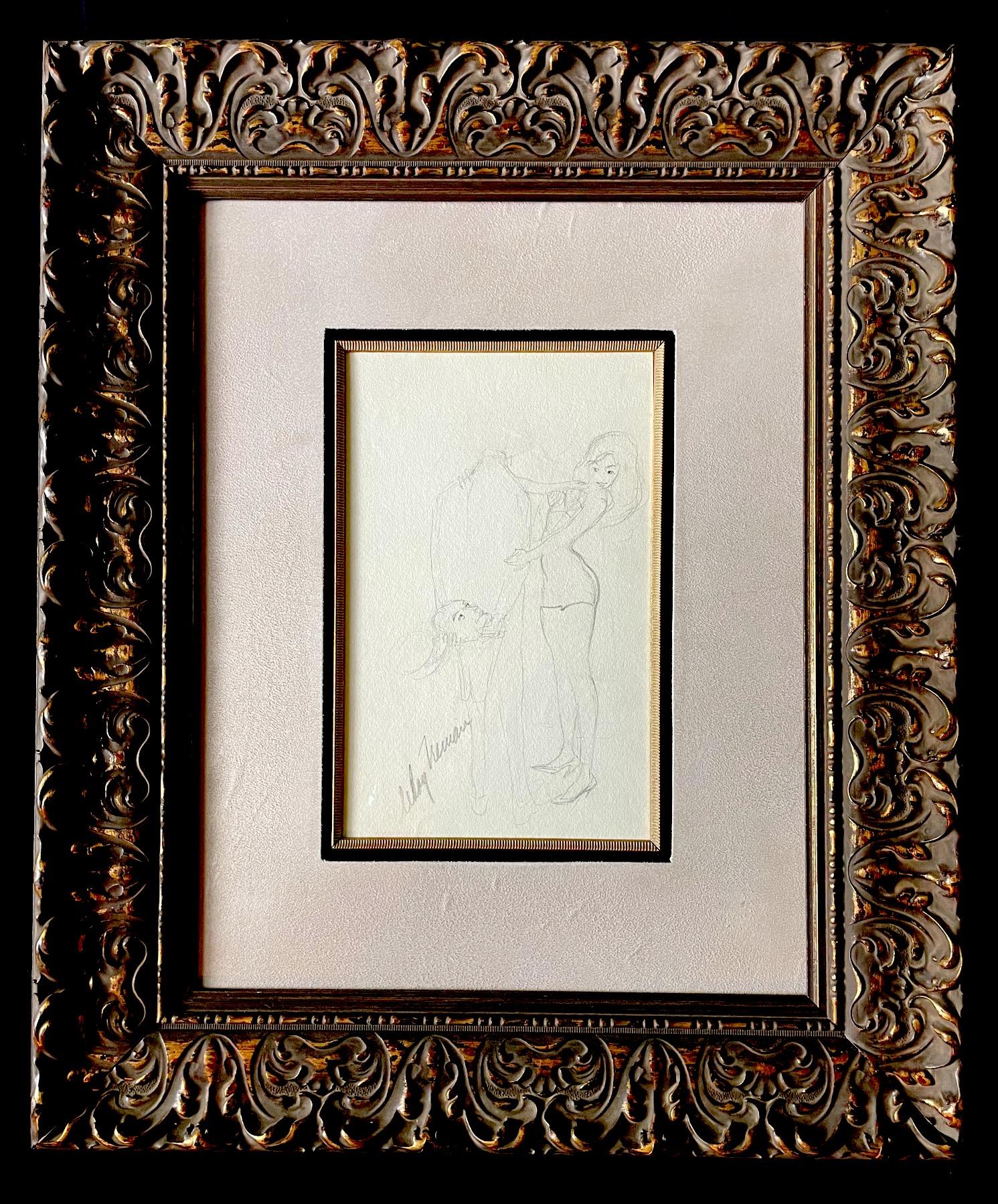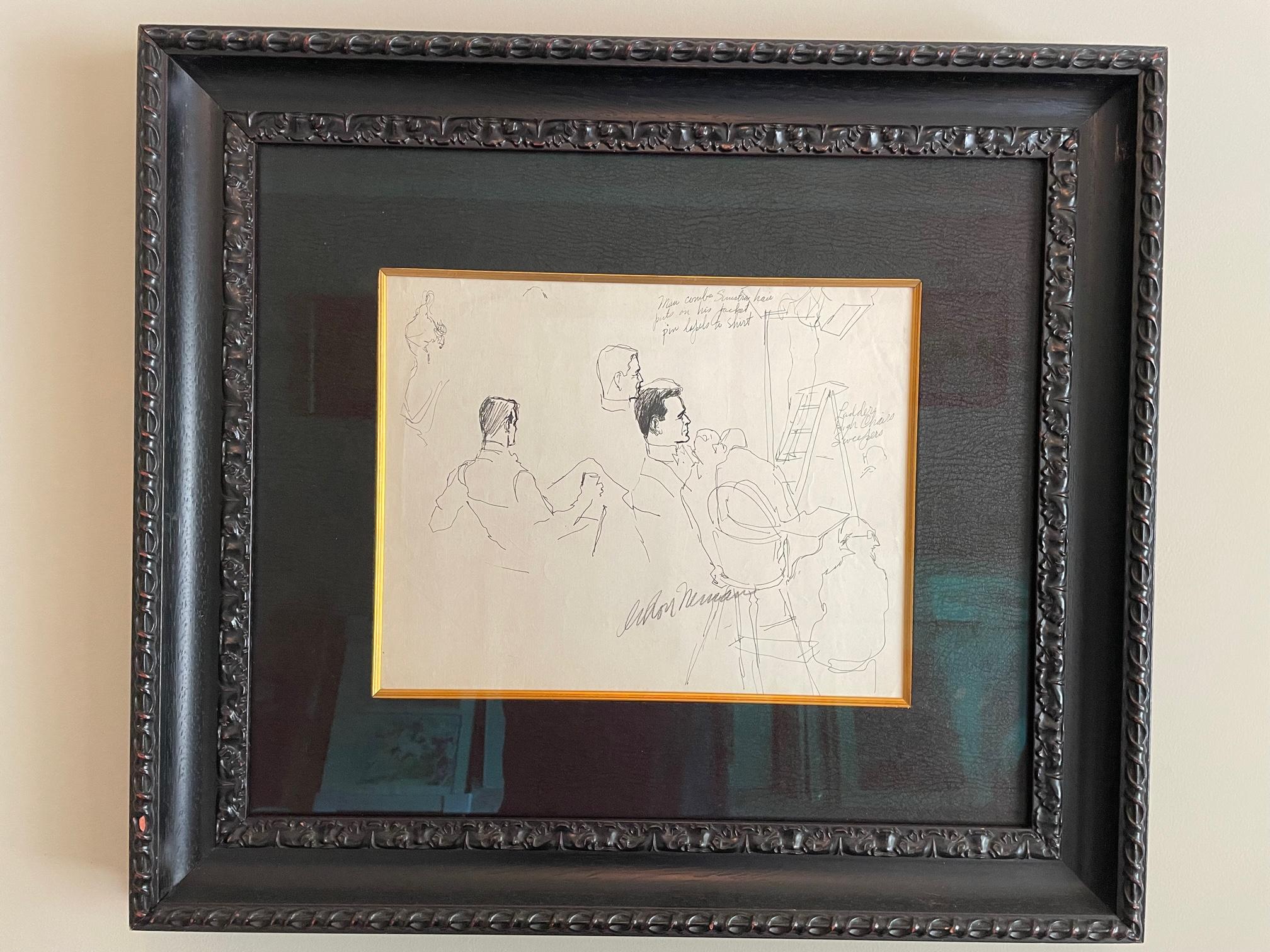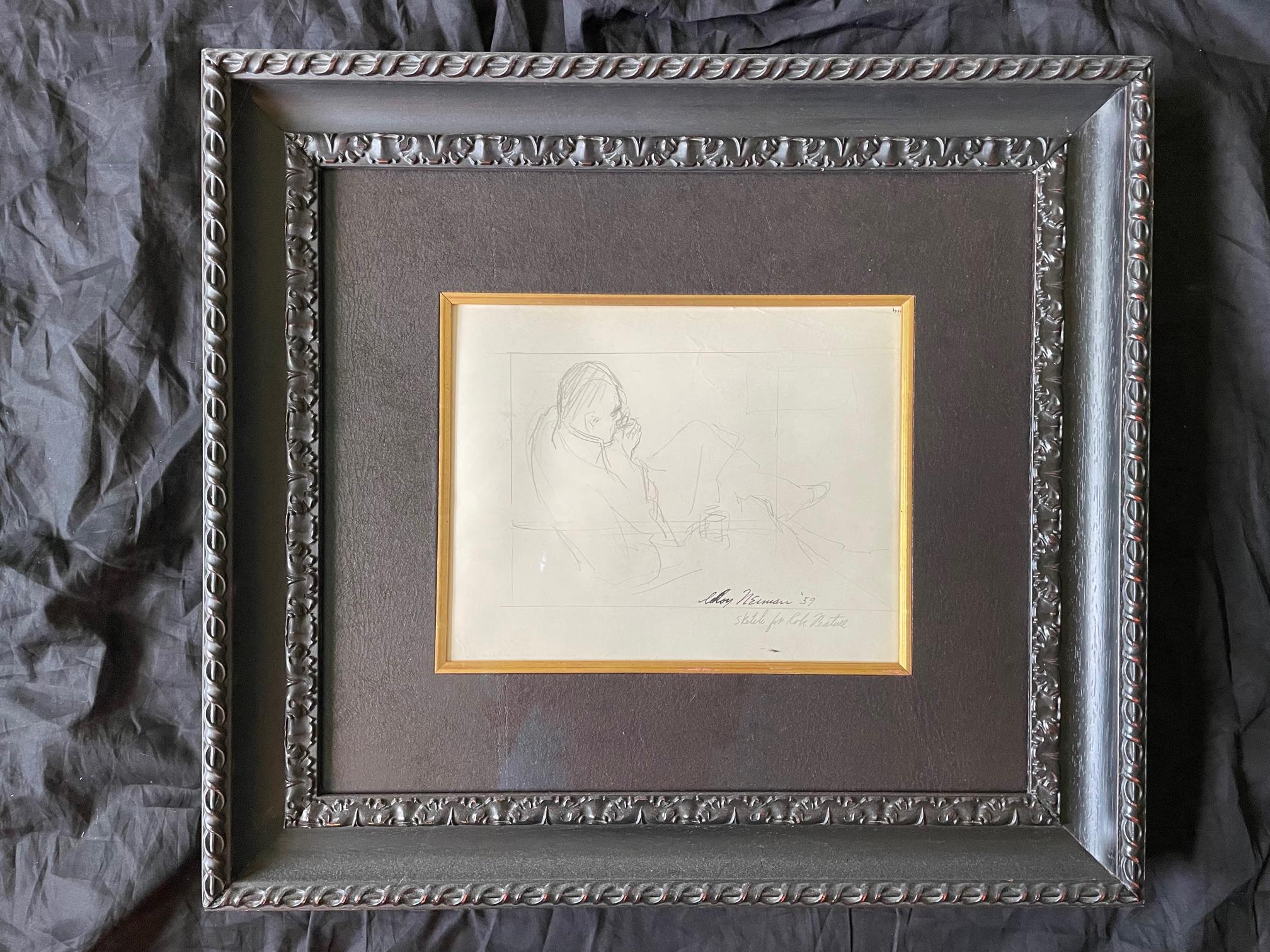Items Similar to Preliminary Study for the painting Rose and Gold, 1913
Want more images or videos?
Request additional images or videos from the seller
1 of 8
William McGregor PaxtonPreliminary Study for the painting Rose and Gold, 19131913
1913
About the Item
Preliminary Study for the painting Rose and Gold, 1913
Graphite on paper, 1913
Signed in pencil lower left (see photo)
Titlted "Lizzy Young" in pencil upper left (see photo)
Lizzy was a modle that Paxton depicts numerous times.
The painting that this drawing is related to, is illustrated in Lee & Krause, William McGregor Paxton, 1869-1941, Plate 32, text on page 132. The painting was formerly in the collection of Victor Spark and the Honorable Paul Buchanan. It is currently in a Texas Collection.
Provenance: Private Collection, Florida
William McGregor Paxton (June 22, 1869 – 1941) was an American painter and instructor who embraced the Boston School paradigm and was a co-founder of The Guild of Boston Artists. He taught briefly while a student at Cowles Art School, where he met his wife Elizabeth Okie Paxton, and at the Museum of Fine Arts School in Boston. Paxton is known for his portraits, including those of two presidents—Grover Cleveland and Calvin Coolidge—and interior scenes with women, including his wife. His works are in many museums in the United States.
Early life
He was born on June 22, 1869, in Baltimore to James and Rose Doherty Paxton. William's father moved the Paxton family and established a catering business in Newton Corner, Massachusetts, in the mid-1870s.
Education
Paxton attended Cowles Art School on a scholarship he attained at the age of 18. He studied with Dennis Miller Bunker and Cowles and then went to Paris to study under Jean-Léon Gérôme, at École des Beaux-Arts.] Maryhill Museum of Art said he also studied at Académie Julian in Paris. He returned to Cowles and studied with Joseph DeCamp, who also taught Elizabeth Vaughan Okie She became Paxton's student and then his wife.
Marriage
Paxton became engaged in 1896 to Elizabeth Vaughan Okie, and they married on January 3, 1899. They traveled to Europe together[4] and often spent their summers on Cape Cod and Cape Ann.] They lived in Newton, Massachusetts, first on Elmwood Street with his parents. About 1916 they resided or had a studio on Ipswich Street in Fenway Studios in Boston. They later purchased a house in Newton Center on Montvale Road.
Paxton's wife managed his career and modeled for many of his works, like the painting in which she was dressed for the ball. "William McGregor Paxton... benefited from an art-savvy wife who supported his career, using her energy in the bet that his offered the more secure future," said author and art historian Rena Tobey. The couple had no children.
Career
Paxton taught from 1906 to 1913 at the Museum of Fine Arts School and painted briefly at Fenway Studios in Boston.] He worked at the Harcourt Street Studios in Boston and when it burned in 1904 he lost close to 100 paintings. He then went to the Fenway Studios for a brief period but then moved on to the Riverway Studios, also in Boston. He is primarily known for his portraits and painted both Grover Cleveland] and Calvin Coolidge. Maryhill Museum of Art says of his artistry, "Paxton was well known for the attention he gave to the effects of light and detail in flesh and fabric. His works often present idealized views of women, such as this portrait (The Red Fan) of his wife Elizabeth", like Henry James's portrayal of women in his novels The Portrait of a Lady (1881) or The American (1877). His models, often daughters and wives of his patrons, were depicted as refined, cultured women of "conspicuous leisure", and equated with the "precious aesthetic objects surround them", like the women of Thorstein Veblen's Theory of the Leisure Class (1899) who reflect the wealth of their husbands or fathers. He crafted elaborate compositions with models in his studio, using props that appear in several paintings.
Paxton and several other Bostonian artists were inspired by Johannes Vermeer. The Metropolitan Museum of Art says of Paxton's Tea Leaves (1909) in their collection:
In a windowless parlor permeated by soft light, a dreamy atmosphere, and the sounds of silence, two elegant women pass the time by doing very little or nothing at all. Paxton hints at a narrative, but he asks that the viewer invent it, recapitulating the ambiguity of Vermeer's paintings, which he admired.[13]
Paxton employed a technique where only one area in his compositions was entirely in focus, while the rest was somewhat blurred, something he called "binocular vision" and credited to Vermeer. He began to employ this system in his own work, including The New Necklace, where only the gold beads are sharply defined while the rest of the objects in the composition have softer, blurrier edges.[15]
Paxton is one of the key figures in the Boston School of painting and a co-founder of The Guild of Boston Artists with Frank Weston Benson and Edmund Charles Tarbell. Between 1926 and 1927, he was interviewed by Dewitt Lockman with 85 other artists and architects associated with the National Academy of Design. Records from the interview are held at the New York Historical Society and the Archives of American Art.[16] Paxton was made a full member of the National Academy of Design in 1928.
Paxton died of a heart attack when he was painting his wife in their Montvale Road living room. He was 72 years of age. An exhibition was held in his memory at the Museum of Fine Arts, Boston from November 19 through December 14, 1941. His papers—including sketches, correspondence, and photographs—are held at the Archives of American Art at the Smithsonian Institution in Washington, D.C.
Courtesy Wikipedia
- Creator:William McGregor Paxton (1869 - 1941, American)
- Creation Year:1913
- Dimensions:Height: 12 in (30.48 cm)Width: 8.75 in (22.23 cm)
- Medium:
- Movement & Style:
- Period:
- Condition:
- Gallery Location:Fairlawn, OH
- Reference Number:
About the Seller
5.0
Recognized Seller
These prestigious sellers are industry leaders and represent the highest echelon for item quality and design.
Platinum Seller
These expertly vetted sellers are 1stDibs' most experienced sellers and are rated highest by our customers.
Established in 1978
1stDibs seller since 2013
711 sales on 1stDibs
Typical response time: 1 hour
Associations
International Fine Print Dealers Association
- ShippingRetrieving quote...Ships From: Akron, OH
- Return PolicyA return for this item may be initiated within 10 days of delivery.
More From This SellerView All
- Girl with the Golden CurlsBy Everett ShinnLocated in Fairlawn, OHGirl with the Golden Curls Watercolor, c. 1895 Unsigned Provenance: Davis Galleries, New York (see photo of label on reverse) Condition: Mounted to support by the artist A few imperfections (bubbles) in the mounting Original frame Image size: 6 3/4 x 4 1/2 inches Frame size: 13-1/2 x 11-1/4 x 3/4 inches A charming pre Ashcan work by the artist. Done while he was making his living as a commercial illustrator for advertsing and magazines. Everett Shinn (1876-1953) In 1897, Shinn moved to New York City to work as an illustrator at the New York World. He became fascinated by the drama of the city. While visiting Europe in 1900, Shinn took interest in the work of the Impressionists, particularly those of Degas. Degas’ influence can be read in Shinn’s depictions of American theater. From his acquaintances in the theater world, Shinn began to paint decorative “rococo revivalist” murals in the homes of the wealthy elite. He also worked extensively in pastel, portraying the rough life of the city. In 1908, Shinn exhibited alongside his Charcoal Club associates, with the addition of Arthur B. Davies, Ernest Lawson, and Maurice Prendergast...Category
1890s American Impressionist Figurative Drawings and Watercolors
MaterialsWatercolor
- "And wasn't it good for a boy to be Out to old Aunt Mary's"By Howard Chandler ChristyLocated in Fairlawn, OH"And wasn't it good for a boy to be Out to old Aunt Mary's" Charcoal and watercolor on artist illustration board, 1900 Initialed and dated lower right: H.C.C. 1900 by the artist (see...Category
Early 1900s American Impressionist Figurative Drawings and Watercolors
MaterialsCharcoal
- The Red DressBy Robert HallowellLocated in Fairlawn, OHThe Red Dress Watercolor on paper, mounted on board by the artist, 1926 Signed and dated, 1926 lower left (see photo) Condition: Mounted on support board by...Category
1920s American Impressionist Figurative Drawings and Watercolors
MaterialsWatercolor
- CourtshipBy Robert HenriLocated in Fairlawn, OHCourtship Graphite and black crayon, c. 1905 Signed by the artist in pencil lower left (see photo) Most probably inspired by a Paul Gavarni lithograph and executed while the artist w...Category
Early 1900s American Impressionist Figurative Drawings and Watercolors
MaterialsCrayon
- Woman with childBy Robert HallowellLocated in Fairlawn, OHWoman with child Watercolor on paper, c. 1930 Signed with the estate stamp lower right (see photo) Exhibited: Marbella Gallery, New York Illustrated: Robert Hallowell: An Artist Redi...Category
1930s American Impressionist Figurative Drawings and Watercolors
MaterialsWatercolor
- Sketch of a woman's head in profileBy Sir William OrpenLocated in Fairlawn, OHSketch of a woman's head in profile Graphite on paper, c. 1900-1910 Unsigned Condition: Excellent Tiny tear upper right near hinge (repaired and bearly visible) Sheet size: 4 5/8 x 3...Category
1910s Impressionist Figurative Drawings and Watercolors
MaterialsGraphite
You May Also Like
- Planes of the HeadBy Lu HaskewLocated in Loveland, CO"Planes of the Head" by Lu Haskew Graphite on Paper 14x12" framed, 10x8" image size ABOUT THE ARTIST: Lu considered it a must to work with live models once ...Category
Early 2000s American Impressionist Figurative Drawings and Watercolors
MaterialsArchival Paper, Graphite
- Studies for MedusaBy John Singer SargentLocated in New York, NYImage size: 16 x 20 ½ inches This is a study for the body of Medusa in Perseus on Pegasus Slaying Medusa, 1922-25, the mural panel installed on the ceiling side aisle of the Hunting...Category
1920s American Impressionist Nude Drawings and Watercolors
MaterialsPaper, Charcoal, Graphite
- He Lost His Head Over HerBy LeRoy NeimanLocated in Cumming, GAOriginal Graphite on Paper Dimensions 12.5″ x 8″ Viewable 27″ x 22.5″ Framed. Signed by Artist. Circa 1962.Category
1960s American Impressionist Figurative Drawings and Watercolors
MaterialsGraphite
- Original Sinatra on the SetBy LeRoy NeimanLocated in Cumming, GAOriginal Graphite and Pen Sketch on Paper 12 1/4″ x 15 5/8″ Viewable 26″ x 29 1/2″ Framed Circa 1960’sCategory
1960s American Impressionist Figurative Drawings and Watercolors
MaterialsGraphite
- Figure Study For 'Science'By John Singer SargentLocated in New York, NYImage dimensions: 24 ½ x 18 ¾ inches Framed dimensions: 34 x 28 inches This charcoal drawing is a preliminary study for the figure of Science, the subject that comprises the far ri...Category
1920s American Impressionist Figurative Drawings and Watercolors
MaterialsPaper, Charcoal, Graphite
- Original Richard Burton, The Robe FilmBy LeRoy NeimanLocated in Cumming, GAOriginal Graphite Sketch on Paper 1953 / Signed 1959 Inscribed “Sketch for Robe Feature” 10 5/8″ x 13 1/2″ Viewable 25″ x 29 1/2″ Framed The Robe, a fictional Biblical epic film was ...Category
1950s American Impressionist Figurative Drawings and Watercolors
MaterialsGraphite




